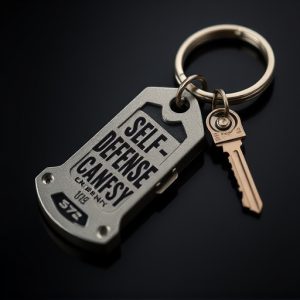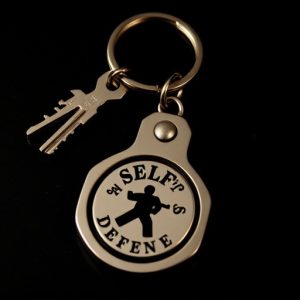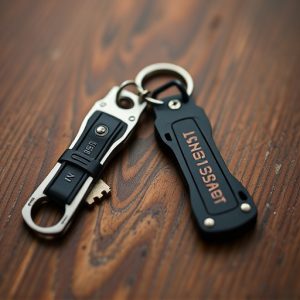Launching Your Self Defense Keychain Business: A Comprehensive Guide
Market research is key to launching a successful self-defense keychain business. Identify target cus…….
Market research is key to launching a successful self-defense keychain business. Identify target customers (e.g., college students, urban dwellers) and tailor products, marketing, and pricing accordingly. Develop functional, innovative keychains with tools like stun guns or pepper spray, while adhering to legal regulations and safety standards. Utilize digital marketing, influencer partnerships, and community events to build awareness and gain customer loyalty through workshops and demonstrations. Strategically plan production, logistics (including supplier relationships), and excellent customer service to thrive in the competitive market.
Starting your own self-defense keychain business can be a rewarding venture, empowering individuals with a simple yet effective tool for safety. This guide navigates the process from market research to product development, legalities, marketing, and operations.
Identify your target audience—whether urban professionals or outdoor enthusiasts—and design keychains that meet their unique needs. Understand the legal landscape surrounding self-defense products to ensure compliance. Utilize digital marketing strategies to reach customers, and establish efficient production, logistics, and customer service practices to stand out in the competitive self-defense keychain market.
Market Research and Target Audience Identification
Market research is a crucial step in launching any successful business, and a self-defense keychain business is no exception. Begin by understanding your target market and identifying your ideal customer. Self-defense keychains appeal to a diverse range of individuals, from everyday people seeking peace of mind to professionals who rely on personal safety tools for their jobs. Conducting surveys, analyzing competitors, and studying industry trends will help you define your niche.
Focus on factors such as age groups, gender, lifestyle, and geographic locations to narrow down your target audience. For instance, college students, urban dwellers, outdoor enthusiasts, or individuals in high-risk professions might be more inclined to invest in self-defense keychains. By pinpointing these specific segments, you can tailor your marketing efforts, product designs, and even pricing strategies to meet their unique needs and preferences, ensuring a strong foundation for your self-defense keychain business.
Product Development: Designing Effective Self-Defense Keychains
When developing your self-defense keychain business, the key to success lies in crafting not just functional but also effective products. Each keychain should be designed with a clear purpose, incorporating features that enable users to defend themselves in various situations. Consider incorporating tools like a small stun gun, pepper spray, or even a simple but sharp edge for breaking glass. Ensure these features are discreetly built into the keychain to maintain its portability and everyday usability. The design should blend seamlessly with popular keychains, ensuring it appeals to a wide market without compromising on functionality.
In terms of product development, research is paramount. Study existing self-defense tools and keychains to understand what works best in the market. Identify gaps in current offerings and aim to fill them with innovative yet practical solutions. For instance, you could focus on creating keychains that double as emergency lights or those with advanced noise-making capabilities to startle attackers. Remember, your goal is to create a product that is not just a keychain but a reliable companion for personal safety, catering to the needs of individuals who prioritize their well-being and peace of mind.
Legal and Regulatory Considerations for Starting a Small Business
Starting any small business, especially one that deals with products related to self-defense like keychains, comes with a set of legal and regulatory considerations. It’s crucial to understand the local laws and requirements governing the sale of self-defense items. This includes obtaining any necessary licenses or permits for retail sales and ensuring compliance with safety standards. For instance, some regions have specific regulations on the force allowed in self-defense devices, which can impact product design and marketing claims.
Additionally, businesses must navigate consumer protection laws that dictate how products are advertised, sold, and warranted. Given the sensitive nature of self-defense keychains, it’s essential to provide clear and accurate information about their effectiveness and limitations. Understanding labor laws and tax obligations is also critical for maintaining a compliant business structure. Proper planning in these areas can help ensure your self-defense keychain business operates smoothly and within legal boundaries.
Marketing and Sales Strategies for Your Keychain Business
In the competitive market of self-defense tools, establishing a unique selling point for your keychain business is essential. One effective strategy is to leverage digital marketing channels such as social media and influencer partnerships. By showcasing the compact yet powerful nature of your keychains, target audiences can easily envision carrying them daily. Content creation focusing on survival tips, personal safety stories, or product demonstrations can attract a dedicated following. Additionally, offering limited-edition designs or collaborations with outdoor/adventure brands can generate buzz among potential customers.
Sales-wise, diversifying distribution channels is key to expanding your self-defense keychain business. Alongside online sales platforms, consider partnerships with local outdoor gear stores, survival shops, or even fitness centers catering to self-defense enthusiasts. Implementing a referral program where satisfied customers encourage their friends can also boost sales. Furthermore, hosting workshops or demonstrations at community events or schools can raise awareness about the importance of self-defense and increase product visibility.
Production, Logistics, and Customer Service Best Practices
Starting a self-defense keychain business requires meticulous planning and execution, especially in terms of production, logistics, and customer service best practices. Production involves sourcing high-quality materials, designing innovative yet practical keychains, and ensuring each piece meets safety standards for self-defense functionality. Consider using durable and lightweight materials that offer a comfortable grip and effective defense mechanisms, such as pepper spray or alarm features. Efficient assembly lines and quality control measures will help maintain consistent product excellence.
Logistics encompass everything from inventory management to shipping. Establish partnerships with reliable suppliers to ensure a steady supply of raw materials and components. Implement streamlined order fulfillment processes to meet customer demands promptly. For self-defense keychain businesses, offering fast shipping options and providing tracking information can enhance customer satisfaction. Additionally, effective return and exchange policies are crucial to building trust with your audience. Focus on responsive customer service to address inquiries, resolve issues, and foster a positive brand image in the competitive self-defense keychain market.


